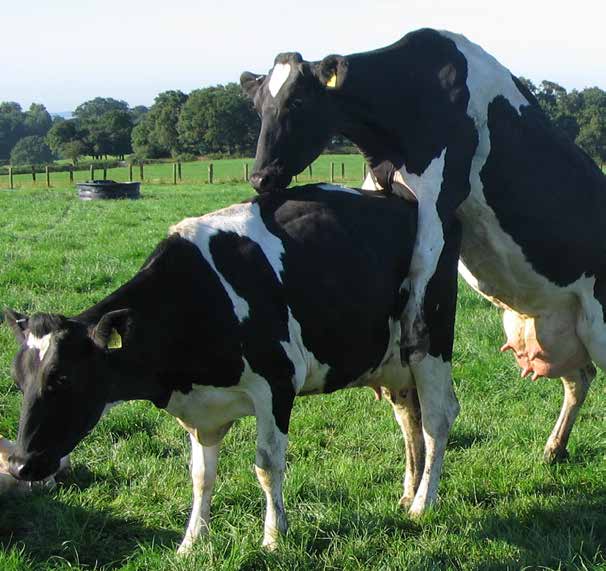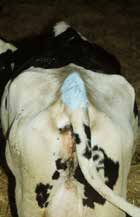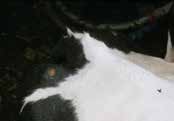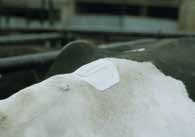Xlvets.co.nz

XLVets Fact Sheet
Reprduction & Fertility RF
The Oestrus Cycle MISSED HEATS
Detection of oestrus or heat
Heat detection and
involves being able to observe and
record behaviour associated with
cycling. The most reliable sign is
dealing with problems
observing a standing response
when ridden. There are various
reasons why heats are missed;
usually because cows are not
showing heat strongly or staff are
The average oestrus cycle of the cow is 21 days, ranging between 18 – 24
not observing cows when they are
days. Heifers start cycling at the onset of puberty and will continue to cycle
until they are in calf. The onset of puberty can be affected by various factors
The main causes of this are:
such as nutrition, growth rate (poorly grown heifers will take much longer to
• Increased herd size leading to
reach puberty and start cycling), breed, and disease. After calving mature
more cows per member of staff.
cows usually take a minimum of 35-42 days to start cycling again, whereas
• Failure to recognise oestrus due
heifers usually take longer – up to 10 days longer. This may be extended in
to inadequate staff training.
high yielding cows or those affected by disease post calving.
• Looking at the wrong time of day.
The oestrus cycle is governed by the complex interactions of various
hormones that are produced in the brain and ovaries; progesterone and
• Poor environment: Slippery
oestrogen being two of these. The follicle (egg) grows throughout the cycle
floors and overcrowding will
and ovulation (the release of the egg) occurs when the progesterone levels
reduce the chance of cows
drop and the oestrogen rises. A structure called the corpus luteum then forms
exhibiting normal oestrus
on the ovary, which then produces progesterone. Any cows that haven't
cycled after 35-42 days should be examined by your vet to check for any
• Short weak oestrus: The average
abnormalities and to help maximise her chances of early conception.
cow is in oestrus for a shorter
period than she was 25 years
ago. This has partly been blamed
• Altered behaviour – such as
on increasing milk yields.
Oestrus is defined as the period of
changing order in which she is
maximal sexual activity. The average
usually milked, coming back to the
duration is thought to be only eight
shed after milking.
hours for the modern dairy cow,
• Clear vulval mucus (‘bulling string').
however it can range from 2 - 30 hours. • Rub marks/sores over the tail head.
There are various signs and different
animals will express these to varying
• Mounting other cows, particularly
mounting the cow from head on.
Oestrus signs include:
• Standing to be mounted.
• Increased restlessness (including
• Saliva or mud marks on the flanks
bellowing) and activity.
from other cows mounting her.
• Decreased feed intake and milk
The Oestrus Cycle
Days of oestrus cycle
This graph shows the waves of progesterone and oestrogen, with the cow being in
heat during the surge in oestrogen. If the cow does not become pregnant this is
repeated. If she is pregnant the progesterone level remains high.
XLVets Committed to NZ farming




XLVets The Oestrus Cycle
Reprduction & Fertility RF
Improving heat detection
Heat detection may be further
For good heat detection there must be:
improved by:
• Detecting and recording pre mating heats –
Clear identification of cows by freeze
branding or clean easy to read ear tags
these give an idea of when cows will be on
(ideally in both ears).
heat again, and will help reduce the chances
of heats being missed if they are quiet. Pre
• A good system outlining the staff
mating heat detection will also give an early
members responsible for heat detection
idea of the herds cycling status and will
and how those cows will be identified
therefore allow early planning of veterinary or
and removed from the herd for AI, or
nutritional intervention if needed.
recorded only if bull matings.
• Heat mount detectors. These are stuck on the
• Regular oestrus observation. Try and
on the tail head of the cow and are triggered
set aside three periods of 20 – 30
by the pressure of another cow mounting them,
minutes throughout the day that are not
associated with feeding or milking, for
leading to a colour change. Examples of these
heat detection. Most mounting activity
are Kamars™, or Estrotect™ scratchies.
will take place between 6pm and 6am
• Tail paint. This works by a similar principle to above
so it is important to observe cows during
with paint rubbed off by mounting behaviour. This
this period. A good time of day is two
needs to be reapplied when it becomes dry and
hours after the cows have been locked
cracked, touch ups twice weekly are recommended.
away in the paddock when the majority
of cows are settled and sexually active
• Motion detectors/pedometers. These are attached
groups may be more apparent.
to either the neck or leg bands respectively and any
increases in walking activity are remotely detected and
• A good recording system, either
recorded on a computer. These can be very useful
computerised or manual, with all heats
but care must be used in interpreting them as there
recorded into a central place.
may be other reasons for increased activity – such as
• Adequate light to ensure cows can be
calves in nearby paddocks or other stock movements
seen in heat and identified.
past the paddock.
COST OF LONGER CALVING TO CONCEPTION
There are many costs associated with an extended calving to conception
interval – most notably a lower 6 week in calf rate which means less
There are various hormone
days in milk. The relative cost per day increases the longer the interval
treatments available for both cows
and includes extra feed costs, loss of milk yield (days in milk/production
that have cycled pre mating, and
efficiency) and potentially increased veterinary costs.
those that are anoestrus (‘not
Ensuring cows are at target Body Condition Score (BCS) at calving (5 for
cycling'). In some herds it may
cows and 5.5 for heifers), as well as having a condensed calving pattern
be appropriate to use hormone
will help encourage cows to start cycling with sufficient time prior to the
regimes to allow fixed time AI or
planned start of mating (PSM).
to allow compacted periods of
heat detection. There are several
Veterinary intervention can be a tool to help detect problems and get
options and the most appropriate
cows cycling earlier. Prompt and early examination by a vet will lead to
one for your herd can be discussed
identification of anoestrus ovaries, ovarian cysts and other abnormalities.
with your vet.
This can help shorten the time until she is mated (and conceives) which
ultimately increases days in milk and shortens time until she is at peak
lactation for the next season.
For more information contact your local XLVets practice:
XLVets Committed to NZ Farming. Go to www.xlvets.co.nz
Source: http://www.xlvets.co.nz/sites/xlvets.co.nz/files/The%20Oestrus%20Cycle.pdf
In Vitro - Ex Vivo Correlation of Fluticasone Propionate Pharmacokinetic Profiles Maria Börjel1,2, Ewa Selg2 and Per Gerde1,2 ([email protected]) 1 Inhalation Sciences Sweden AB, Stockholm, Sweden; 2 Institute of Environmental Medicine, Karolinska Institutet, Stockholm, Sweden INTRODUCTION In inhalation drug development there is a need not only for traditional particle
vie. 29 abr 2016 "LA GRAN BATALLA QUE SE IMPONE ES LA NECESIDAD DE UNA LUCHA ENÉRGICA Y SIN TREGUA CONTRA LOS MALOS HÁBITOS Y LOS ERRORES (.)" FIDEL CASTRO RUZ UN PRINCIPIO JUSTO, DESDE EL FONDO DE UNA CUEVA, PUEDE MÁS QUE UN EJÉRCITO La Última La voz de los más pequeños Jorge Javier Miranda Márquez






